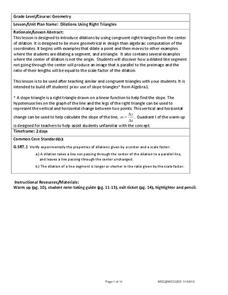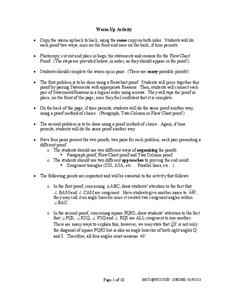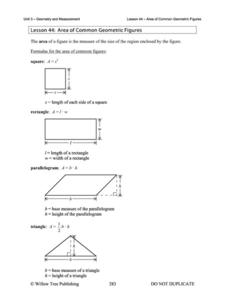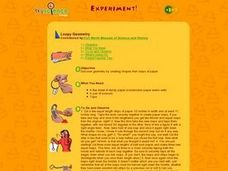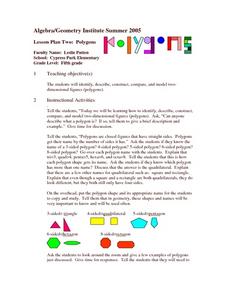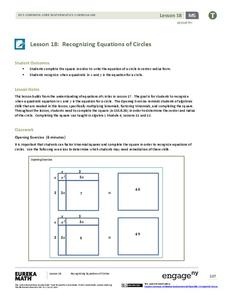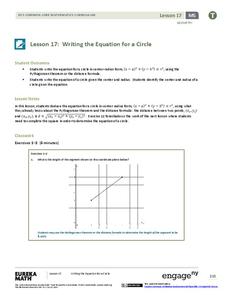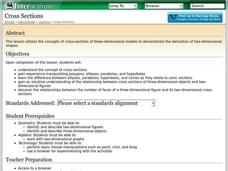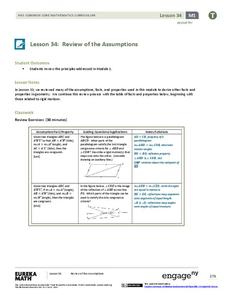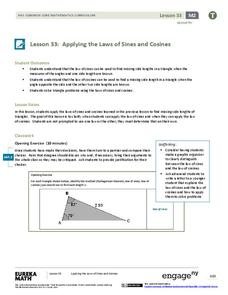West Contra Costa Unified School District
Dilations Using Right Triangles
Don't argue with a triangle that has a 90-degree angle. It's always right. Scholars first use right triangles to help draw dilations of points. They continue the lesson plan by applying this skill to draw dilations of polygons.
West Contra Costa Unified School District
Investigating Special Right Triangles
Scholars first investigate relationships in the side lengths of 30°-60°-90° triangles and 45°-45°-90° triangles. This knowledge then helps them solve problems later in the lesson plan about special right triangles.
Curated OER
Circumcenter of a Triangle
Your geometry learners will discover and show the construction of the circumcenter of a triangle. Guided by the steps in the activity, they construct perpendicular bisectors of each side that have a point of concurrency called the...
Willow Tree
Area of Common Geometric Figures
Scholars can use area formulas, but can they apply what they know about area? The lesson challenges learners to think logically while practicing finding area of shapes such as rectangles, circles, parallelograms, triangles, and other...
Curated OER
Exploring Geometry and Algebra using Cabri Jr. Application.
Learners solve geometric problems with algebra and graphing in this lesson. They will prove the bisectors theorem using the Cabri Jr. application, which requires Cabri on their TI.
Curated OER
Loopy Geometry
Students explore geometric shapes by creating them through paper. In this geometric shape lesson, students bend, cut and shape paper to create geometric shapes. Students discover how many ways they can produce new shapes....
Curated OER
Lesson Plan Two: Polygons
Learners explore the concept of polygons on a two-dimensional plane. They identify polygons in everyday life and draw different polygons according to their classification. Using a geoboard and geobands, they consrtuct polygons and even...
Curated OER
Interactivate - Geometry in Tessellations
Students use an on-line worksheet to experiment with patterns of tessellations in regular polygons. As students observe different shapes in the "Tessellate" Activity they complete a data table and practice making predictions for...
Curated OER
Escher-Esque Tessellations
Middle and high schoolers participate in a seven-part lesson creating Escher-Esque tessellations. They demonstrate their knowledge of geometric transformations after viewing a PowerPoint presentation, conducting Internet research, and...
Curated OER
Shape Up!
An outstanding lesson on teaching the basic shapes and polygon names to young geometers is here for you. In it, learners investigate the role of basic polygons in the strength of structures. They use geoboards, rubber bands, streamed...
Curated OER
Miras, Mirrors, and Kaleidoscopes!
Students use hands-on activities to explore transformations. They view a video segment that demonstrate how M. C. Escher employed geometry and transformations to create so many of his famous drawings.
Captain Planet Foundation
Fall into Healthy Shapes
Kindergartners identify geometric shapes by planting a fall garden. They start their seeds in containers that have different shapes, and keep track of their plants based on those shapes. This brilliantly designed and incredibly thorough...
Curated OER
SuperShapes, Part 1; "Tri"ing Triangles
An outstanding lesson on triangles awaits your math scholars. Learners focus on the triangle, which is the strongest of all polygons. They see the role that triangles play in the design of buildings, and learn about triangle...
Curated OER
Discovering Pi/Welcome to Pi Day
High schoolers explore pi. In this circle measurement lesson, students define and identify radius, diameter, circumference, and perimeter. High schoolers work in groups to measure several plastic lids and record their findings. Students...
EngageNY
Recognizing Equations of Circles
What does completing the square have to do with circles? Math pupils use completing the square and other algebraic techniques to rewrite equations of circles in center-radius form. They then analyze equations of the form x^2 + y^2 + Ax +...
EngageNY
Writing the Equation for a Circle
Circles aren't functions, so how is it possible to write the equation for a circle? Pupils first develop the equation of a circle through application of the Pythagorean Theorem. The lesson then provides an exercise set for learners to...
Shodor Education Foundation
Cross Sections
Use this activity on cross-sections of three-dimensional shapes in your math class to work on algebra or geometry Common Core standards. The lesson includes a list of relevent terminology, and a step-by-step process to illustrate the...
EngageNY
Review of the Assumptions (part 2)
Is the amount of information getting overwhelming for your geometry classes? Use this strategy as a way to organize information. The resource provides a handout of information studied in relation to triangle congruence. It includes a...
EngageNY
Incredibly Useful Ratios
Start the exploration of trigonometry off right! Pupils build on their understanding of similarity in this lesson that introduces the three trigonometric ratios. They first learn to identify opposite and adjacent...
EngageNY
Sine and Cosine of Complementary Angles and Special Angles
Building trigonometric basics here will last a mathematical lifetime. Learners expand on the previous lesson in a 36-part series by examining relationships between the sine and cosine of complementary angles. They also review the...
EngageNY
The Volume Formula of a Pyramid and Cone
Our teacher told us the formula had one-third, but why? Using manipulatives, classmates try to explain the volume formula for a pyramid. After constructing a cube with six congruent pyramids, pupils use scaling principles from...
EngageNY
Equations for Lines Using Normal Segments
Describing a line using an algebraic equation is an essential skill in mathematics. The previous lesson plan in the series challenged learners to determine if segments are perpendicular with a formula. Now they use the formula to...
EngageNY
Applying the Laws of Sines and Cosines
Breaking the law in math doesn't get you jail time, but it does get you a wrong answer! After developing the Law of Sines and Cosines in lesson 33 of 36, the resource asks learners to apply the laws to different situations. Pupils must...
EngageNY
Inscribed Angle Theorem and Its Applications
Inscribed angles are central to the lesson. Young mathematicians build upon concepts learned in the previous lesson and formalize the Inscribed Angle Theorem relating inscribed and central angles. The lesson then guides learners to prove...
Other popular searches
- Math Art Geometry Lessons
- Math Geometry Lessons
- Esl Lessons Math Geometry
- Esol Lessons Math Geometry
- Mummy Math Geometry Lesson
- Math Geometry Lesson Plans


